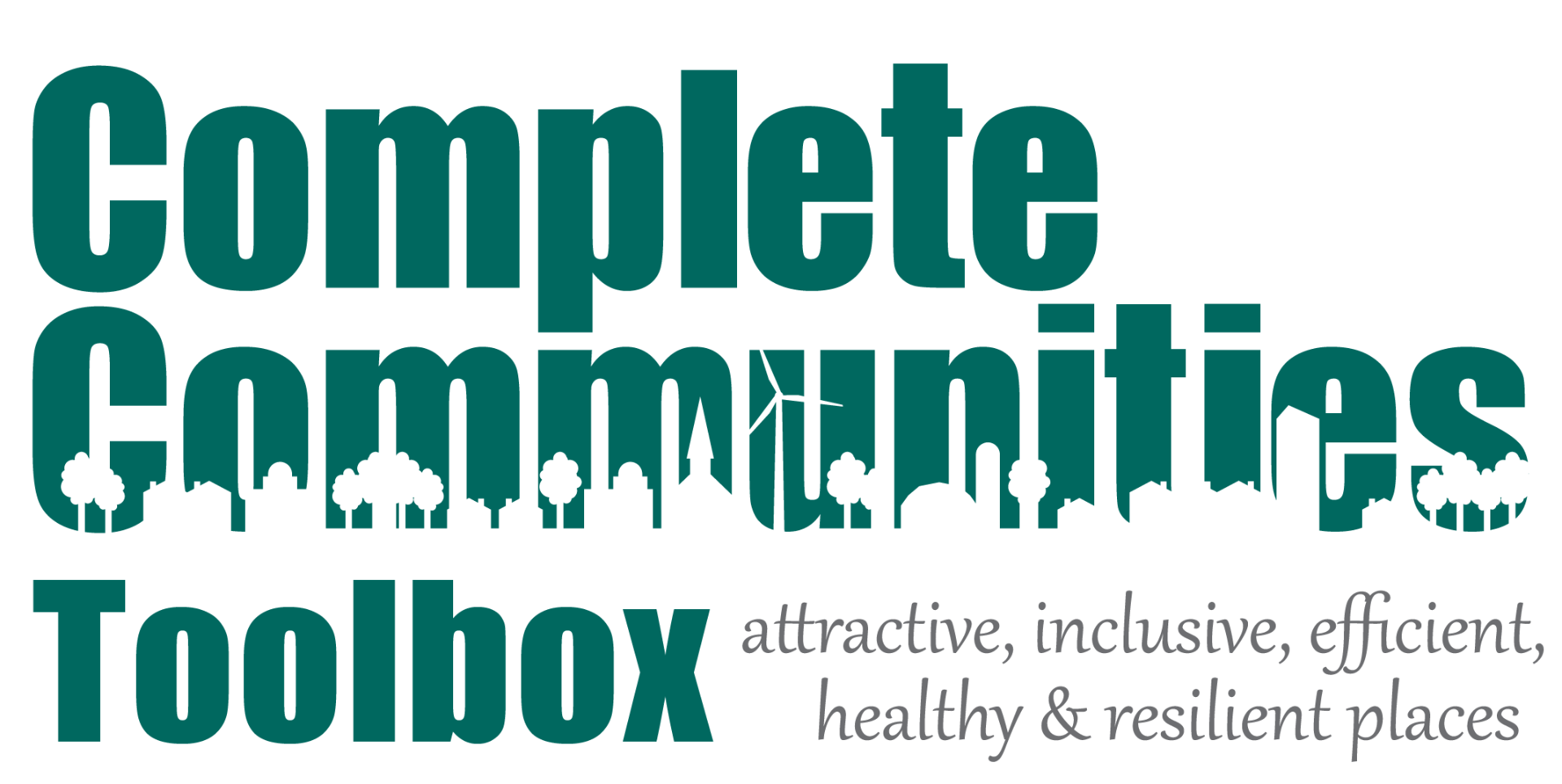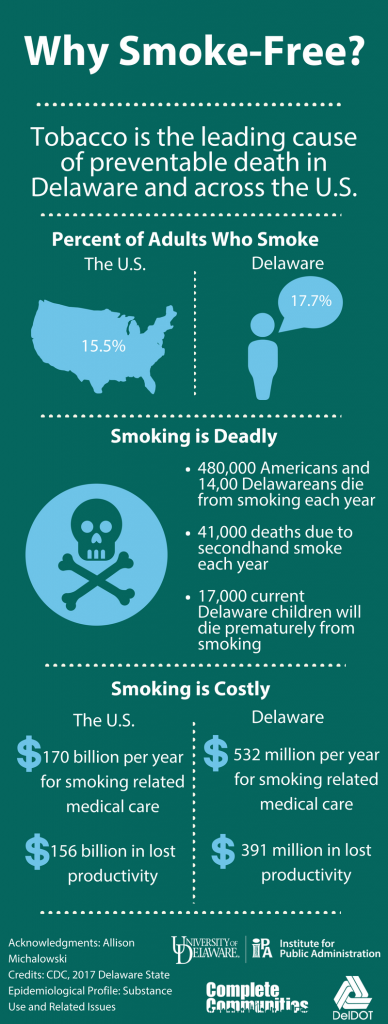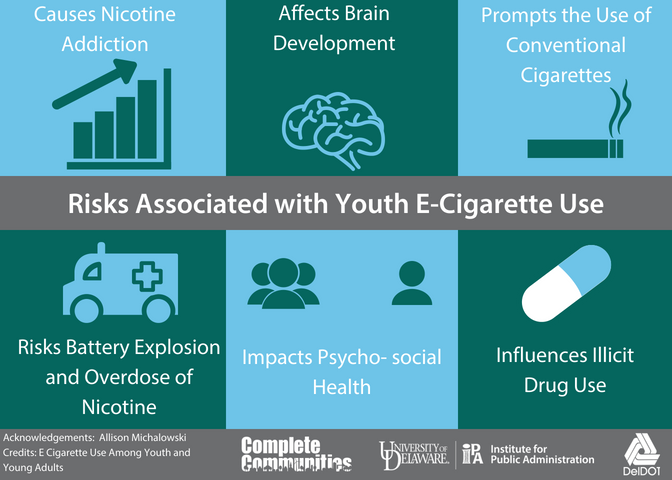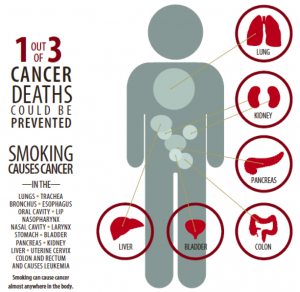
Diseases and Health Problems Linked to Smoking. Source: Let’s Make the Next Generation Tobacco-Free: Your Guide to the 50th Anniversary Surgeon General’s Report on Smoking and Health
Smoke-free practices are key to creating healthy communities. This section on Smoke-Free Delaware guides municipalities in developing policies that protect its residents’ health through the creation of more smoke-free public spaces.
- Why Smoke Free?
- Electronic Cigarettes
- Delaware’s Clean Indoor Air Act
- Smoke-Free Local Policies
- Point-of-Sale Smoke-Free Strategies
- Secondhand Smoke and Marijuana
- Resources on Smoke-Free Policies for Local Governments
Why Smoke Free?
Nonsmokers who breathe secondhand smoke consume toxic chemicals just as tobacco-users do. The 2006 U.S. Surgeon General Report concluded that there is no safe level of exposure to secondhand smoke, and that taking in even small amounts causes lung cancer, heart disease, and respiratory distress in both adults and children.
Establishing policies to reduce exposure to secondhand smoke is one of the key objectives of Healthy People 2020, a set of goals and objectives released every ten years by the U.S. Department of Health and Human Services to guide national health promotion and disease prevention. While scientific research and policy efforts have primarily focused on indoor exposure, a growing body of evidence has found that exposure to secondhand smoke outdoors can also pose a significant risk.
Preventing secondhand smoke exposure is one initiative in a larger effort to reduce the effects of tobacco consumption. Combating smoking initiation and supporting smoking cessation are also important aspects of creating a smoke-free Delaware. A strong network of nonprofit and government organizations also offer cessation programs to help smokers quit, peer-mentoring to prevent youth from starting to smoke, and campaigns to educate the public about the dangers of smokeless, as well as traditional, tobacco products.
Exposure to second-hand smoke has been shown to cause cancer and respiratory and cardiovascular diseases in adults. Racial and ethnic minorities, people with lower incomes, and workers in occupations such as construction and the service industries have been found to have higher levels of exposure to secondhand smoke. With the broad adoption of state and local indoor smoking bans over the last decade exposure levels are down for all populations, but disparities persist.
Electronic Cigarettes
What are Electronic Cigarettes?
Electronic cigarettes, more commonly referred to as e-cigarettes, are devices that heat a liquid into an aerosol that the user inhales. The liquid usually contains nicotine and other flavorings and additives. E-cigarettes are commonly known as e-cigs, mods, e-hookahs, vape pens, and tank systems. In Delaware, e-cigarettes are considered tobacco products and included in Delaware’s Clean Indoor Air Act.
E-Cigarette Use Among Youths
Soaring use of e-cigarettes among young people “is now a major public health concern,” according to the December 2016 report from the U.S. In the preface to the report, the Surgeon General wrote that e-cigarette use among high school students increased “an astounding 900 percent” from 2011 to 2015.
The report finds that e-cigarettes are now the most commonly used tobacco product among youths, surpassing tobacco cigarettes. According to the Surgeon General, most e-cigarettes contain nicotine, “which can cause addiction and can harm the developing adolescent brain.” The Surgeon General urged stronger action to prevent young people from getting access to e-cigarettes.
In 2014, the Delaware General Assembly passed HB241, a bill to amend Title 11 Chapter 5 Subsection V of the Delaware Code regarding youth access to tobacco. The bill added a definition for tobacco substitutes to include e-cigarettes. The legislation makes it illegal to sell or distribute e-cigarettes to minors.
Risks of E-Cigarettes
A 2018 research study at Johns Hopkins found that the liquids and aerosols used in e-cigarettes contain several toxic metals such as lead and nickel at levels greater than the recommended maximum exposure levels. Furthermore, e-cigarettes, like traditional cigarettes, contain nicotine, which is harmful and addictive. The Surgeon General’s report details many of the negative harmful effects nicotine has on particularly at-risk groups including youth and pregnant women. Given the significant risks associated with e-cigarettes, it is important to consider them when crafting local smoke-free policies.
Healthy Delaware Vape Toolkit
The Healthy Delaware Vape Toolkit prepared by the Delaware Cancer Consortium offers resources to help communities combat vaping, especially among students. The toolkit provides an overview of the vaping epidemic in Delaware, with factsheets explaining the signs and effects of vaping and educational resources and curriculum for teachers, parents, and healthcare providers. The Toolkit also offers cessation tips and tricks to help teens quit and additional resources such as informative fact sheets, presentations, and websites dedicated to making people aware of the health risks and dangers of vaping.
Delaware’s Clean Indoor Air Act
Initially passed in 2002, Delaware’s Clean Indoor Air Act works to protect nonsmokers from involuntary exposure to tobacco smoke in most enclosed spaces to which the public is invited. The smoke-free policies addressed in this act apply to the entire state of Delaware. To encourage, develop, and implement smoke-free policies, it is important to understand the smoke-free policies that currently apply to the community. The video below summarizes and explains key details of Delaware’s Clean Indoor Air Act.
Smoke-Free Local Policies
IMPACT Delaware Tobacco Prevention Coalition set forth several goals to help governing bodies across the state work toward creating a smoke-free Delaware. In order to make progress toward the goals set forth by IMPACT Delaware as well as toward the Surgeon General’s call for a smoke-free generation, municipalities need to enforce existing policies and implement new policies. Population-based smoking interventions have had the greatest impact on smoking declines in the years since the Surgeon General Warning. Local communities can use local codes to address the three categories of smoking behaviors:
- Initiation
- Maintenance
- Cessation
In 2013, Delaware issued a smoking ban for all state government campuses. Private organizations like some universities, parking lots, and outdoor sports complexes have also banned smoking on their grounds. On the local level, many Delaware communities have implemented smoke-free ordinances for outdoor public spaces including parks, beaches, and city property. In addition, towns can also implement point-of-sale ordinances.
Smoke-Free Public Spaces
When people smoke in public places, both the smoker and others visiting the public space are exposed to the harmful effects of smoking. Furthermore, seeing others smoke in public places perpetuates unhealthy smoking norms. Public spaces should be safe for visitors and promote healthy lifestyles, so it is important to make public spaces smoke-free. To encourage local governments to work toward creating smoke-free public spaces, the U.S. Department of Health and Community Services’s Healthy People 2020 set an objective for all 50 states to pass laws eliminating smoking in public places. Additionally, the Office on Smoking and Health at the Centers for Disease Control and Prevention makes eliminating exposure to secondhand smoke one of its main goals.
View the Creating Smoke-Free Public Spaces Spark Page to learn more about creating ordinances that establish a smoke-free environment.
Point-of-Sale Smoke-Free Strategies
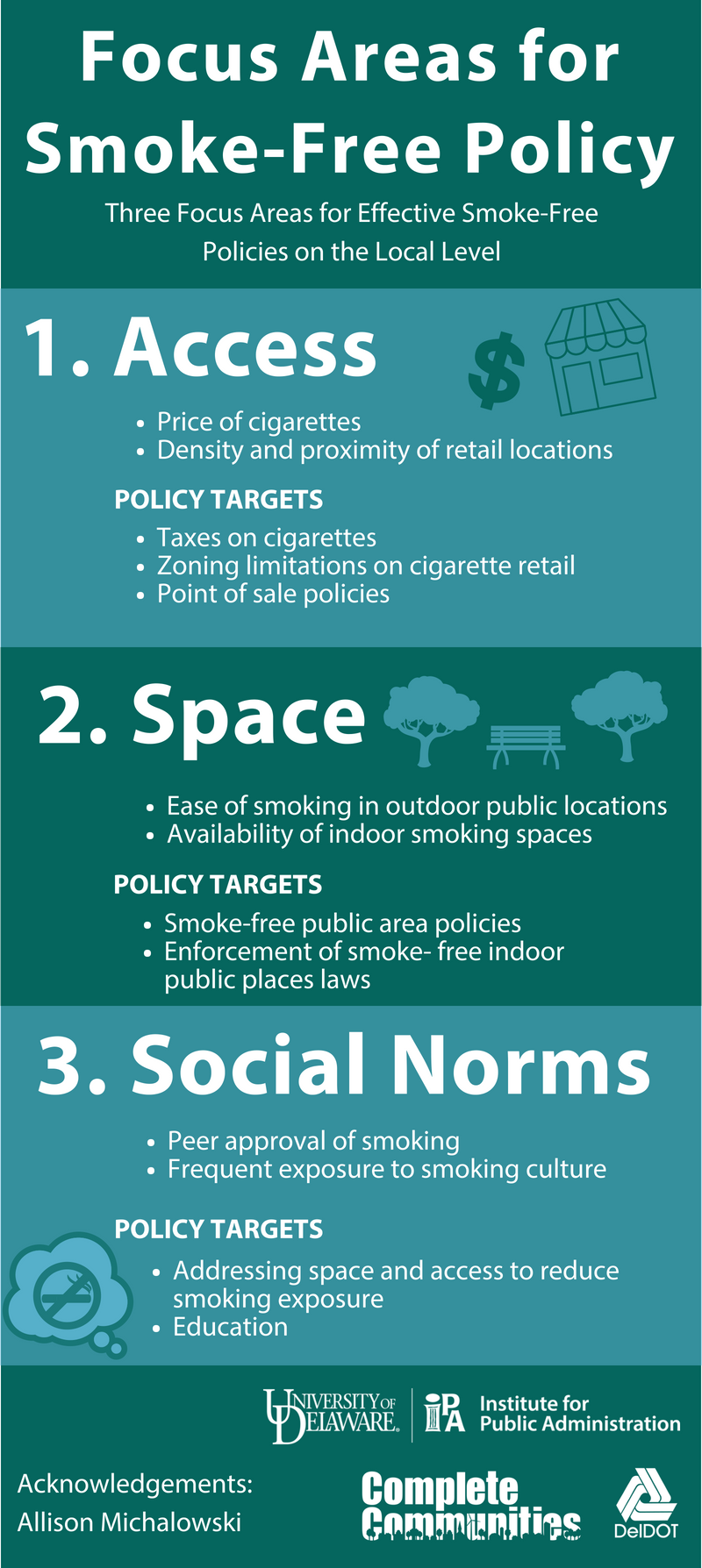 Limit Locations
Limit Locations
Point-of-sale based policies target the accessibility of tobacco products through strategies like advertisement limitation and restrictions on tobacco retail locations. Across the country, many municipalities use zoning codes to limit where tobacco can be sold. For example, Dover, Delaware, does not allow tobacco shops in its neighborhood commercial zone. Limiting the approved zoning areas for tobacco sale can reduce the total number of shops that sell tobacco and help increase the distance people need to travel to access tobacco.
Limit Density
While zoning laws can help limit the locations of tobacco shops, another option is to limit the amount of business licenses given to stores to sell tobacco in a defined area. This option limits the density of tobacco shops, so that the overall number of tobacco shops decreases and people need to travel farther to access tobacco. These policies can help address the fact that zones in which tobacco sales are approved may be concentrated in certain areas. By restricting the number of approved tobacco vendors, the overall retail accessibility of tobacco decreases even in areas where commercial zoning may allow for tobacco sale.
Limit Access
People are less likely to initiate tobacco use and more likely to successfully quit smoking when tobacco is harder to access. Delaware uses tactics like increased taxes to make tobacco more expensive, so that it is harder to access. Land use and retail approval are highly dependent on local legislation, so it is important to combine state and local efforts to reduce access to tobacco.
Secondhand Smoke and Marijuana
Over the past several years, marijuana has been in the policy and news spotlight as states have passed laws ranging from limited allowances for medical marijuana to overall marijuana legalization. While smoking marijuana remains illegal in Delaware, the National Survey on Drug Use and Health found that 13% of Delawareans reported using marijuana within the past year and 9% reported using marijuana in the last month.
Is Secondhand Marijuana Smoke Harmful?
Since smoking marijuana remains illegal in most of the country, there is little data concerning the effects of secondhand marijuana smoke. However, the evidence that is present suggests secondhand marijuana smoke should be avoided. Research has shown that secondhand marijuana smoke contains many of the same carcinogenic chemicals as tobacco smoke. In fact, secondhand marijuana smoke contained more of the harmful chemicals known as hydrogen cyanide and PAHs than secondhand tobacco smoke contains. Another study found that 1 minute of exposure to secondhand marijuana smoke results in cardiovascular impairment similar to and lasting longer than secondhand tobacco smoke exposure.
Secondhand Marijuana Smoke Around Children
For years, every level of government has been working to reduce childhood exposure to secondhand tobacco smoke, and a recent study by Columbia University shows that progress is being made. However, as the percent of parents who smoke tobacco around their children has decreased, the percent of parents who smoke marijuana around their children has increased.
What Can Communities Do?
Since buying, selling, and smoking marijuana is illegal statewide, point-of-sale strategies and smoke-free public space policies would be difficult to implement. Instead, municipalities should focus their efforts on teaching residents the harmful impacts of secondhand marijuana smoke. These strategies have helped decrease the percent of current smokers who smoke around their children, so marijuana secondhand smoke preventative campaigns could be modeled based on past tobacco secondhand smoke preventative campaigns.
Should marijuana become legal in Delaware, local municipalities should include marijuana in their smoke-free public places and point-of-sale laws. In Colorado, where smoking marijuana is legal, residents are not allowed to smoke, eat, or vape marijuana in any public places or on federal land. These smoking regulations are actually stricter than Colorado’s tobacco smoking regulations.
Resources on Smoke-Free Policies for Local Governments
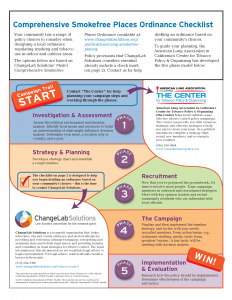 Finding Resources
Finding Resources
Creating smoke-free policies can be complicated. From determining the best type of policy for your municipality to determining who needs to be involved in creating the policy, there are countless variables to consider. Model ordinances are available to help municipalities across the country navigate the political process and create effective smoke-free policy.
Tobacco Control Trainings
Established in 2001 through grants from the American Cancer Society (ACS), the American Legacy Foundation (Legacy) and The Robert Wood Johnson Foundation (RWJF) the Tobacco Technical Assistance Consortium (TTAC) provides technical assistance, information resources, and training for state and local tobacco control programs. As part of the Emory Centers for Training and Technical Assistance, its mission is to build capacity within the field to achieve effective tobacco prevention and control programs and policies. TTAC provides individualized technical assistance and customized trainings to help clients succeed in their tobacco control efforts.
Model Ordinances and Reports
In addition to the Tobacco Technical Assistance Consortium, the resources below include reports on how to most effectively navigate the political process of passing smoke-free policies and smoke-free model ordinances:
- Comprehensive Smoke-Free Places from Change Lab Solutions
- Tobacco-Free Outdoor Areas from the Public Health and Tobacco Policy Center
- Outdoors from the Public Health Law Center
- Point-of-Sale Strategies a Tobacco Control Guide from the Tobacco Legal Consortium
- Point of Sale Initiative Meeting with Decisionmakers Checklist from the Center for Public Health and Tobacco Policy
- Point-of-Sale Report to the Nation: The Tobacco Retail and Policy Landscape from State and Community Tobacco Control Research
Additionally, local resources provide important information to Delaware consumers and health care professionals. The November 2015 edition of the Delaware Journal of Public Health is dedicated to providing information on tobacco prevention and control in Delaware. Featured articles focus on concerns and potential risks associated with e-cigarette use, the state’s tobacco control program, and millennial generation perspectives on the future of ending tobacco use in Delaware.

